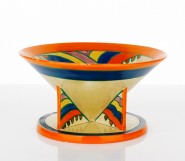Lot #54 - Andy Warhol
-
Auction House:Deutscher and Hackett
-
Sale Name:Important Australian + International Fine Art
-
Sale Date:04 May 2016 ~ 7pm
-
Lot #:54
-
Lot Description:Andy Warhol
(1928 – 1987, American)
Ladies And Gentlemen, 1975
set of 10 colour screenprints , edition: artist’s proof 11/25, aside from an edition of 125 (10)
85.0 x 67.5 cm each
signed, numbered and dated verso -
Provenance:Warhol Foundation, New York; Jeffrey Ruesch Fine Art, New York; Private collection, New South Wales, acquired from the above in 2001
-
Exhibited:Andy Warhol’s Ladies and Gentleman, Palazzo Diamante, Ferrara, Italy, October 1975, and Romani Adami, Rome, November 1975 (another example); Andy Warhol, Gallery of Modern Art, Brisbane, 8 December 2007 – 13 April 2008 (another example)
-
References:Feldman, F., and Schellmann, J., Andy Warhol Prints: A Catalogue Raisonné 1962 – 1987, Ronald Feldman Fine Arts, New York, 1997, cat. II.128 – 137, pp. 86 – 87, (illus., another example)
-
Notes:‘Today, stars are their own managers. Before there were people who did this, now you have to do everything yourself. It’s the same with art.’1 Arguably the most influential artist of the twentieth century, Andy Warhol revolutionised modern art, radically altering notions of authorship and commodity to confound distinctions between art and life, ‘high’ and ‘low’ art and above all, between artist and public, whose tastes and values not only came to coincide but became inseparable. Pioneering techniques now commonplace in contemporary art, Warhol employed a vocabulary of mass-produced images from advertising and the celebrity press to present art as essentially another commercial enterprise – an act filled with equal parts indifferent banality, ingenious marketing and celebration. Applauded as a mirror of contemporary American culture in which, he notoriously predicted, everyone would experience (or want to experience) ‘fifteen minutes of fame’, Warhol thus actively cultivated celebrity with his glittering reflections of the upper echelons of society attesting to that aspect of his practice he unapologetically described as ‘business art’. As art historian Robert Rosenblum suggests, his legacy may be considered in the venerable European tradition of portrait painting, with Warhol ‘the ideal court painter to the 1970s international aristocracy that mixed, in wildly varying proportions, wealth, high fashion and brains.’ 2 That Warhol believed anyone could be a star is encapsulated superbly by the present series of glamorous portraits, Ladies and Gentlemen, 1975. While immediately evoking the allure of celebrity, the suite is, however, far removed from the earlier Jackie, Marilyn or Liz portraits which celebrate established personalities and derive from images made ‘public’ by virtue of their appearance in the media. Rather, Warhol here draws inspiration from Polaroid photographs he himself had taken of anonymous drag queens and transsexuals sourced by Interview magazine editor, Bob Colacello, from a Greenwich Village nightclub, ‘The Gilded Grape’. Predominantly of mixed-race and Hispanic origin, these models represented for Warhol the ultimate expression of the movie star presence he so eagerly sought to capture. Drawing heavily upon Hollywood idols, such individuals dedicated their lives to the performance of their self-fashioned personas, becoming manufactured icons in their own right. As Warhol pondered at the time upon the role of gender and artifice in self-image, ‘I wonder whether it’s harder for 1) a man to be a man; 2) a man to be a woman; 3) a woman to be a woman; or 4) a woman to be a man. I don’t really know the answer, but from watching all the different types, I know that the people who think they’re working the hardest are the men trying to be women. They do double-time… I guess it’s interesting to try to be another sex.’3 Bestowing a ‘glamour effect’ through the use of flamboyant colour, pose and accentuation of make-up intended to simulate fictional identities, thus Warhol immortalises anonymous figures of the promiscuous mixed-race American scene at the time denied visibility or marginalised by clichés relegating them to the fringes of community life. While mimicking the celebrity status of his other portraits, in its ambiguity and anonymity the series nevertheless veers away from the commerciality so often associated with Warhol’s work to explore a more abstract and elusive notion of fame. Similarly, the technique of photographic images printed upon torn paper collage employed here departs from Warhol’s highly mechanical silkscreened works of the previous decade to reveal, rather, traces of the artist’s hand - effectively belying his infamous declaration that ‘I just want to be a machine.’4 Indeed, like the best of his achievements, Ladies and Gentlemen remains deliberately enigmatic – Warhol seems to demand that his audience look beyond the visual seduction of the image surface, yet he himself remains ever passive and superficial, elucidating very little in terms of meaning. 1. Warhol cited in Bonito, O.A. (ed.), Andy Warhol: The American Dream, MdM Museum, Porto Cervo, Italy, 2013, p. 70 2. Rosenblum, R., ‘Andy Warhol Court Painter to the 70s’, in Andy Warhol Portraits of the 70s, Whitney Museum, New York, 1979, p. 15 3. Warhol, A., The Philosophy of Andy Warhol (From A to B and Back Again), New York, 1975, p. 98 4. Warhol, A. in interview with Swensen, G. published in 'What Is Pop Art? Interviews with Eight Painters (Part 1)’, Art News, New York, November 1963 VERONICA ANGELATOS
-
Estimate:A$40,000 - 60,000
-
Realised Price:
-
Category:Art
This Sale has been held and this item is no longer available. Details are provided for information purposes only.










